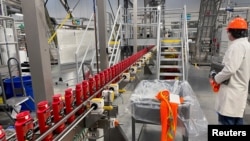The increase in U.S. consumer prices eased in August, the Labor Department reported Tuesday, in a sign that perhaps inflationary pressures are starting to wane as the country’s economy continues to recover from the effects of the coronavirus pandemic.
Data showed prices increasing by three-tenths of a percent in August compared with July, breaking an eight-month streak of rising or steady inflation for consumers, whose spending accounts for 70% of the U.S. economy, the world’s largest.
Over the past year, U.S. prices are up 5.3%, a slight improvement over the previous 5.4% annualized gains in June and July, which had been the highest 12-month increases since 2008.
Even as the U.S. mostly recorded month-after-month price gains this year, White House economic officials and policy makers at the Federal Reserve, the country’s central bank, contended that inflation would ease as the economy improves, particularly as the supply chain of consumer products improves to meet the demands of shoppers.
Even with the August easing of price increases, the inflation rate has a way to go before reaching the Fed’s traditional 2% annual target.
The surge in Delta variant cases of the coronavirus — 150,000 new cases daily in recent weeks — has lent new uncertainty to U.S. economic fortunes and consumers’ willingness to spend, whether it be for home improvements, a new or used car or vacation travel.
In a separate report, the U.S. Census Bureau reported Tuesday that median household income in the U.S. in 2020 totaled $67,500, down 2.9% from the year before.
Only 235,000 new jobs were added in the U.S. in August, down from more than 2 million combined in June and July. That’s a drop President Joe Biden blamed on the spread of the Delta variant.




